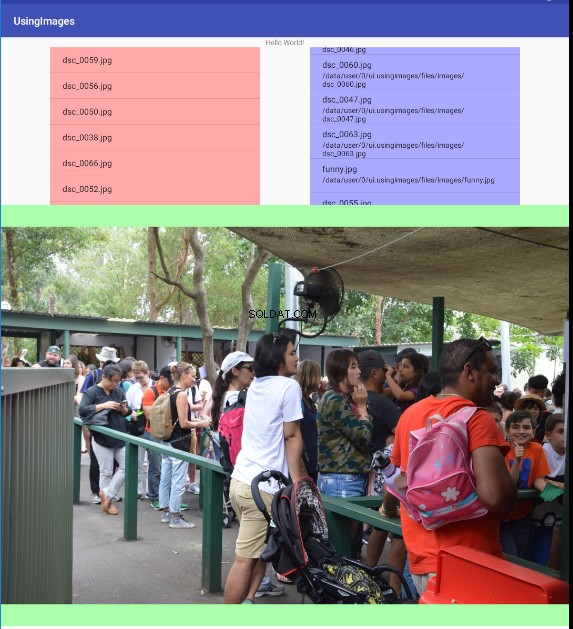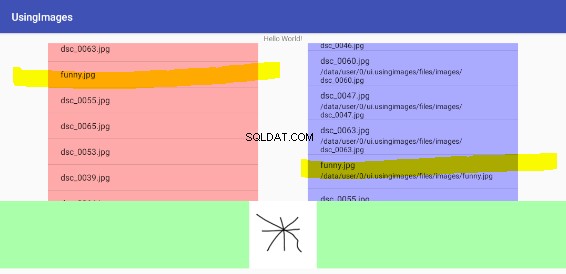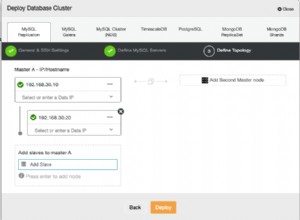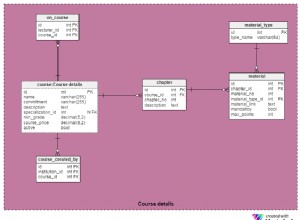Sie extrahieren das Bild als Byte [] und konvertieren es dann entweder in die Bytes als Zeichenfolge aus hexadezimalen Zeichen und schließen diese Zeichenfolge dann in X' ein your_hexadecimal_string '
- zB. es könnte
X'FFFEFDFCFBFA9........'sein
und verwenden Sie diese Zeichenfolge als Wert, der über natives SQL
eingefügt werden soll- zB.
INSERT INTO your_table (image_column) VALUES(X'FFFEFDFCFBFA9........')
Oder Sie könnten die SQliteDatbase insert verwenden Convenience-Methode, die ein Contentvalues-Objekt als dritten Parameter verwendet. Sie würden das Contentvalues-Objekt in etwa so einrichten wie
ContentValues cv = new Contentvalues();
cv.put("Image",your_image_as_a_byte_array);
db.insert("the_table_name",null,cv);
Das Speichern von Bildern kann jedoch mühsam sein und es wird nicht empfohlen, Bilder zu speichern, insbesondere wenn sie im Durchschnitt eine Größe von über 100 KB haben.
Wenn ein Bild nahe oder größer als 2 MB ist, können Sie dieses Bild nicht mit der Standard-Android-SQLite-API abrufen, da ein CursorWindow eine Beschränkung von 2 MB hat. Selbst bei 1M könnten Sie vielleicht 1 Bild in einem CursorWindow erhalten.
Die empfohlene Methode besteht darin, den Pfad oder einen Teil des Pfads zum Bild zu speichern und das Bild bei Bedarf über seinen Pfad abzurufen.
Beispiel
Das Folgende ist eine App, die das Bild entweder in der Datenbank speichert, wenn es unter 100 KB liegt (public static final int MAX_FILE_SIZE = 100 * 1024; ) oder speichern Sie den Pfad und rufen Sie das Bild entweder über den Pfad oder die Datenbank ab, je nachdem, was gespeichert wurde.
Die App hat zwei ListViews mit den Bildbeschreibungen (die ganz rechte enthält den Pfad zum Bild). Durch Klicken auf ein Element in beiden wird das Bild angezeigt.
z. B.

Es gibt eine Reihe von Bildern, die meisten über 100.000, ein funny.png ist unter 100.000 :-

Die Bilder wurden für dieses Beispiel im Raw-Ordner des Res-Ordners abgelegt, sie werden dann in den Ordner data/data/files/images kopiert (wobei der Name des App-Pakets steht):-

Der DatabaseHelper, DBHelper.java ist :-
public class DBHelper extends SQLiteOpenHelper {
public static final String DBNAME = "images.db";
public static final int DBVERSION = 1;
// The maximum size of an image that should be stored 100K
public static final int MAX_FILE_SIZE = 100 * 1024;
public static final String TB_IMAGE = "image";
public static final String COL_IMAGE_ID = BaseColumns._ID;
public static final String COL_IMAGE_PATH = "image_path";
public static final String COL_IMAGE_NAME = "image_name";
public static final String COl_IMAGE_DESCRIPTION = "image_description";
public static final String COL_IMAGE_SIZE = "image_size";
public static final String COL_IMAGE_IMAGE = "image";
SQLiteDatabase mDB;
/**
* Construct DBHelper, note that it will open the database and
* thus create it if it doesn't exist
* @param context a context from the invoking activity
*/
public DBHelper(Context context) {
super(context, DBNAME, null, DBVERSION);
mDB = this.getWritableDatabase();
}
/**
* Create the table(s)
* @param db
*/
@Override
public void onCreate(SQLiteDatabase db) {
String crtsql = "CREATE TABLE IF NOT EXISTS " + TB_IMAGE +
"(" +
COL_IMAGE_ID + " INTEGER PRIMARY KEY, " +
COL_IMAGE_PATH + " TEXT UNIQUE, " +
COL_IMAGE_NAME + " TEXT, " +
COl_IMAGE_DESCRIPTION + " TEXT, " +
COL_IMAGE_SIZE + " INTEGER, " +
COL_IMAGE_IMAGE + " BLOB DEFAULT x'00'" +
")";
db.execSQL(crtsql);
}
@Override
public void onUpgrade(SQLiteDatabase sqLiteDatabase, int i, int i1) {
}
/**
* Return a Cursor with all the rows from the image table
* @return The Cursor
*/
public Cursor getImageList() {
return mDB.query(TB_IMAGE,null,null,null,null,null,null);
}
/**
* Store an image row in the image table, noting that is the image
* size is small than the max size that the image will be stored as a blob
* otherwise a blob of 1 byte is stored due to the default value.
* @param path the path to the image
* @param description a description for the image
* @return the id (rowid) of the row
*/
public long addImageFromPath(String path, String description) {
ContentValues cv = new ContentValues();
File f = new File(path);
InputStream is;
// If the file doesn't exist don't store a row
if (!f.exists()) {
return -1;
}
// Always store the name, description, path and size
cv.put(COL_IMAGE_NAME,f.getName());
cv.put(COl_IMAGE_DESCRIPTION,description);
cv.put(COL_IMAGE_SIZE,f.length());
cv.put(COL_IMAGE_PATH,f.getAbsolutePath());
// If the size is less than the max then get the filestream
// and convert to a byte[].
// Note if larger then the max file size the default x'00' blob
// will be applied
if (f.length() < MAX_FILE_SIZE) {
byte[] buffer = new byte[(int) f.length()];
try {
is = new FileInputStream(f);
is.read(buffer);
} catch (IOException e) {
e.printStackTrace();
return -1;
}
cv.put(COL_IMAGE_IMAGE,buffer);
}
// Do the insert
return mDB.insert(TB_IMAGE,null,cv);
}
/**
* get the image as a bitmap from the DB if stored, otherwise get it from
* the file, according to the id.
* @param id the id of the row in the image table
* @return the bitmap to be returned (note may be empty bitmap)
*/
public Bitmap getImage(long id) {
byte[] ba = new byte[0];
// If the image is stored in the DB then extract and return the bitmap
if (isStoredAsImage(id)) {
return getImageAsBitMap(id);
}
// If not then get the respective row from the DB
Cursor csr = mDB.query(
TB_IMAGE,
null,
COL_IMAGE_ID+"=?",
new String[]{String.valueOf(id)},
null,
null,
null
);
// Prepare to convert the path to a file
String path = ""; //<<<< default to empty path
File f = new File(path); //<<< default to empty file
// If a valid row was found get the path and File from the row
if (csr.moveToFirst()) {
path = csr.getString(csr.getColumnIndex(COL_IMAGE_PATH));
f = new File(path);
}
// done with the cursor so close it
csr.close();
// If the file exists then return the Bitmap
if (f.exists()) {
return BitmapFactory.decodeFile(f.getAbsolutePath());
}
// return an empty bitmap
return BitmapFactory.decodeByteArray(ba,0,ba.length);
}
/**
* Check to see if an image is stored in the DB,
* note assumes anything less than 8 bytes isn't an image
* @param id the id of the row in the image table
* @return true if like an image is stored, otherwise false
*/
private boolean isStoredAsImage(long id) {
boolean rv = true;
byte[] ba = new byte[0];
// Get the respective row from the image table
Cursor csr = mDB.query(
TB_IMAGE,
null,
COL_IMAGE_ID+"=?",
new String[]{String.valueOf(id)},
null,
null,
null
);
// If a row was found get the blob into byte array ba
// if not then ready to return false
if (csr.moveToFirst()) {
ba = csr.getBlob(csr.getColumnIndex(COL_IMAGE_IMAGE));
} else {
rv = false;
}
// If the byte array ba is less then 8 bytes then ready to return false
if (ba == null || ba.length < 8) {
rv = false;
}
// done with the Cursor so close it
csr.close();
// return the result
return rv;
}
/**
* get the image (assumes isStoredAsImage is used prior to invocation)
* @param id the id of the respective row
* @return the bitmap (may be 0 length)
*/
private Bitmap getImageAsBitMap(long id) {
byte[] ba = new byte[0];
Bitmap bmp;
Cursor csr =mDB.query(
TB_IMAGE,
null,
COL_IMAGE_ID+"=?",
new String[]{String.valueOf(id)},
null,
null,
null
);
if (csr.moveToFirst()) {
ba = csr.getBlob(csr.getColumnIndex(COL_IMAGE_IMAGE));
}
csr.close();
return BitmapFactory.decodeByteArray(ba,0,ba.length);
}
}
Die aufrufende Aktivität MainActivity.java ist :-
public class MainActivity extends AppCompatActivity {
public static final String IMAGES_DIRECTORY = "images";
private static File images_file;
ArrayAdapter<String> mAdapter;
ListView mListView01, mListView02;
ArrayList<String> mImages;
CursorAdapter mCsrAdapter;
Cursor mCsr;
ImageView mImageView;
DBHelper mDBHlpr;
@Override
protected void onCreate(Bundle savedInstanceState) {
super.onCreate(savedInstanceState);
setContentView(R.layout.activity_main);
// get the View/Viewgroup IDs
mListView01 = this.findViewById(R.id.listview001); // File List
mListView02 = this.findViewById(R.id.listview002); // DB List
mImageView = this.findViewById(R.id.imageview001); // Image display
// get an instance of the DBHelper
mDBHlpr = new DBHelper(this);
// Copy images from raw folder to data/data/<package>/Files/images
// Also store all the images in the Database (or not depedning upon size)
getImagesFile(this);
if (getImagesCount() < 1) {
loadRawImages();
storeImagesToDB();
}
// Setup the two ListViews to display image name lists
displayList();
displayListFromDB();
// setup the file list so that when an item is clicked the image is displayed
mListView01.setOnItemClickListener(new AdapterView.OnItemClickListener() {
@Override
public void onItemClick(AdapterView<?> adapterView, View view, int i, long l) {
String imagename = mListView01.getItemAtPosition(i).toString();
displayImage(imagename);
}
});
// setup the DB list so that when an item is clicked the image is displayed
mListView02.setOnItemClickListener(new AdapterView.OnItemClickListener() {
@Override
public void onItemClick(AdapterView<?> adapterView, View view, int i, long l) {
displayDBImage(l);
}
});
}
/**
* Store the images in the images folder to the DB giving then a calculated description
* e.g. image1, image2 .....
*/
private void storeImagesToDB() {
File f = getImagesFile(this);
File[] images = f.listFiles();
int imagecounter = 1;
for (File img: images) {
mDBHlpr.addImageFromPath(img.getPath(),"image" + String.valueOf(imagecounter++));
}
}
/**
* return the directory/folder where the images are stored as a File
* @param context a valid context
* @return the number of images
*/
public static File getImagesFile(Context context) {
if (images_file == null) {
images_file = new File(context.getFilesDir().getPath() + File.separator + IMAGES_DIRECTORY);
if (!images_file.exists()) {
images_file.mkdirs();
}
}
return images_file;
}
/**
* get the number of images
* @return the number of images
*/
public static long getImagesCount() {
File[] files = images_file.listFiles(new FileFilter() {
@Override
public boolean accept(File file) {
return file.isFile();
}
});
return (long) files.length;
}
/**
* Setup/refresh the list of images according to the images folder
* (left ListView)
*/
private void displayList() {
if (mImages == null) {
mImages = new ArrayList<>();
} else {
mImages.clear();
}
mImages.addAll(Arrays.asList(images_file.list()));
if (mAdapter == null) {
mAdapter = new ArrayAdapter<String>(this,android.R.layout.simple_list_item_1, mImages);
mListView01.setAdapter(mAdapter);
} else {
mAdapter.notifyDataSetChanged();
}
}
/**
* Set the image view according to the file
* @param imageName the name of the image (as per the ListView)
*/
private void displayImage(String imageName) {
File img = new File(images_file.getPath() + File.separator + imageName);
if (img.exists()) {
Bitmap bmp = BitmapFactory.decodeFile(img.getAbsolutePath());
mImageView.setImageBitmap(bmp);
}
}
/**
* Set the image view according to the image stored/referred to by the DB
* @param id the id of the respective row in the image table
*/
private void displayDBImage(long id) {
mImageView.setImageBitmap(mDBHlpr.getImage(id));
}
/**
* Setup/refresh the list of images as obtained from the DB (right listview)
*/
private void displayListFromDB() {
mCsr = mDBHlpr.getImageList();
if (mCsrAdapter == null) {
mCsrAdapter = new SimpleCursorAdapter(
this,
android.R.layout.simple_list_item_2,
mCsr,
new String[]{DBHelper.COL_IMAGE_NAME,DBHelper.COL_IMAGE_PATH},
new int[]{android.R.id.text1,android.R.id.text2},
0
);
mListView02.setAdapter(mCsrAdapter);
} else {
mCsrAdapter.swapCursor(mCsr);
}
}
/**
* Load (copy from raw folder to images folder) all images
*/
private void loadRawImages() {
Field[] fields = R.raw.class.getFields();
int resourceID = 0;
String resourceName;
for (Field fld: fields) {
resourceName = fld.getName();
try {
resourceID = fld.getInt(fld);
} catch (IllegalAccessException e) {
e.printStackTrace();
}
Log.d("RAW FLDINFO","name=" + fld.getName() + " ID=" + String.valueOf(resourceID));
copyResourceImageToImages(resourceID,resourceName, true);
}
}
/**
* Copy an image from the raw directory (app/src/main/res/raw directory) to
* the Apps data/data/files/images folder
* @param resourceID ID of the resource
* @param resourceName name of the resource (file name less extension)
* @param throw_exception true if an exception should be thrown
*/
private void copyResourceImageToImages(int resourceID, String resourceName, boolean throw_exception) {
String tag = "CPYRSRCTOIMAGES";
InputStream is = getResources().openRawResource(resourceID);
File of = new File(images_file.getPath() + File.separator + resourceName + ".jpg");
Log.d(tag,"Initiating Copy of File " + of.getName());
int buffer_size = 1024 * 4;
int bytesread = 0;
long bytescopied = 0;
OutputStream os;
byte[] buffer = new byte[buffer_size];
if (!of.exists()) {
try {
of.createNewFile();
} catch (IOException e) {
Log.d(tag,"Error Creating File " + of.getName());
e.printStackTrace();
if (throw_exception) {
throw new RuntimeException("Error Creating Output File" + of.getName());
}
return;
}
}
try {
os = new FileOutputStream(of);
} catch (IOException e) {
Log.d(tag,"Error Creating OutputStream for File " + of.getName());
e.printStackTrace();
if (throw_exception) {
throw new RuntimeException("Error Creating OutputStream for File " + of.getName());
}
return;
}
if (os == null) {
throw new RuntimeException("OutputStream not initialised.");
}
try {
while ((bytesread = is.read(buffer)) > 0 ){
try {
os.write(buffer, 0, bytesread);
} catch (IOException e) {
String msg = "Error Writing to Output File " + of.getName() + " Bytes Copied = " + bytescopied;
Log.d(tag, msg);
e.printStackTrace();
if (throw_exception) {
os.close();
of.delete();
throw new RuntimeException(msg);
}
is.close();
os.close();
of.delete();
return;
}
bytescopied = bytescopied + bytesread;
}
}catch (IOException e) {
String msg = "Error reading Input File " + resourceName + " Bytes Copied = " + bytescopied;
Log.d(tag,"Error Reading Input File " + resourceName);
e.printStackTrace();
if (throw_exception) {
throw new RuntimeException(msg);
}
try {
is.close();
os.close();
of.delete();
} catch (IOException e2) {
e2.printStackTrace();
}
}
Log.d(tag,"File " + of.getName() +" Copied - Bytes Successfully Copied = " + bytescopied);
try {
os.flush();
} catch (IOException e) {
e.printStackTrace();
}
try {
os.close();
} catch (IOException e) {
e.printStackTrace();
}
try {
is.close();
} catch (IOException e) {
e.printStackTrace();
}
}
}




